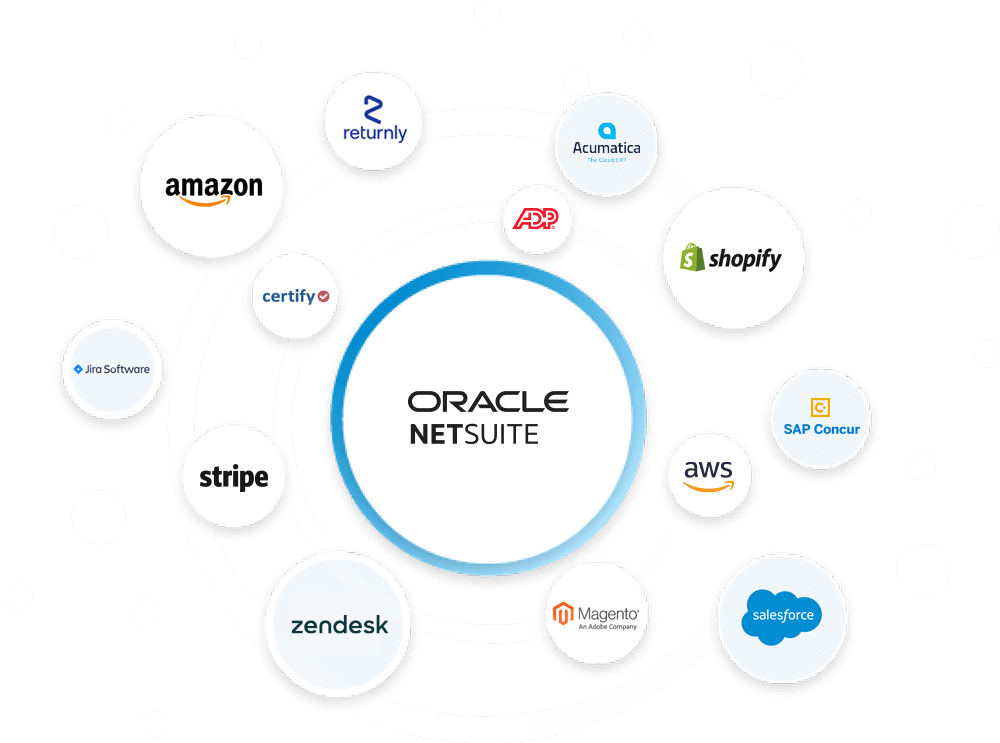About The Project
Customer Relationship Management (CRM) and Enterprise Resource Planning (ERP) systems are the pillars upon which any successful modern company operates. But exactly how do ERP and CRM help a company? The former acts as the conductor of customer relationships, while the latter handles all the vital operational processes – and it’s important that these two act as a powerful duo.
When integrated, CRM and ERP applications provide not only data harmony, but also invaluable insights and a better experience for your customers. But how to make sure that the integration is successful?
This is where our team’s CRM ERP integration tool of choice Celigo steps in – it stands out by providing a practical, multi-platform solution that tends to outperform its competitors. It ensures swift connections and precise data transfer, addressing the common stumbling blocks with advanced error handling.
In this article, we’ll delve into why our expert team prefers Celigo for integration purposes, what benefits to expect from CRM and ERP integration and we’ll also give you tips on how to make the process as smooth as possible.
Understanding CRM and ERP
CRM (Customer Relationship Management) and ERP (Enterprise Resource Planning) are systems that, though distinct in their functions, share a common goal – facilitating the seamless operation of a business.
What is a CRM?
At its core, CRM is a strategic approach to managing and nurturing relationships with customers. The CRM system, often implemented through specialized software, serves as the data center for customer-related activities. Its primary functions include:
- Contact Management: CRM systems centralize customer information, providing a comprehensive repository of contact details, communication history, and preferences. This ensures that businesses have a 360-degree view of their customers.
- Sales and Lead Management: From lead generation to deal closure, CRM systems streamline the sales process. They often include features for tracking leads, managing opportunities, and forecasting sales performance.
- Customer Service and Support: CRM systems facilitate efficient customer service by enabling businesses to track and respond to customer inquiries, issues, and feedback.
- Marketing Automation: CRM systems often integrate marketing functionalities, automating processes such as email campaigns, lead scoring, and analytics.
What is an ERP?
While CRM focuses on customer-centric activities, ERP takes a broader perspective, encompassing the entire spectrum of a business’s operational processes. ERP systems are comprehensive, integrated platforms designed to manage various aspects of business operations, including:
- Finance and Accounting: ERP systems provide tools for managing financial transactions, budgeting, and reporting. They ensure accuracy and compliance with various financial regulations.
- Human Resources: From payroll processing to employee management, ERP systems also streamline human resource functions. This includes features for recruitment, training, and performance evaluation.
- Supply Chain Management: ERP systems optimize the supply chain by managing inventory, procurement, and order fulfillment. This ensures efficient and cost-effective operations.
- Manufacturing and Production: For businesses involved in manufacturing, ERP systems facilitate production planning, quality control, and resource allocation. This in turn also leads to improved efficiency and product quality.
The Need for Integration
As can be concluded from above, CRMs and ERPs can complement each other’s functionality to great success. Therefore, a natural need arises to seamlessly integrate these systems with each other.
But what can you expect to get from the ERP and CRM integration? And what do you risk by not integrating the two systems? Let’s take a closer look.
Holistic Insight into Operations
One of the paramount advantages of integrating CRM and ERP systems is the ability to gain a holistic view of business operations. Post-integration customer interactions captured in the CRM system will seamlessly align with the broader operational data housed in the ERP system.
This paints a comprehensive picture, allowing decision-makers to connect the dots between customer behavior and internal processes. It’s not just about understanding what customers are buying; it’s about discerning why, when, and how these interactions impact the entire operational ecosystem.
Unified Customer Experience
Whether a customer is placing an order, inquiring about a product, or seeking assistance, the integrated systems guarantee a cohesive and personalized interaction.
For instance, a customer service representative armed with integrated data can swiftly address queries about order status, inventory levels, and past purchases. This unified experience not only enhances customer satisfaction but also contributes to brand loyalty.
Data Harmony
Managing data across disparate sources is akin to walking on a tightrope without a safety net. ERP CRM integration acts as that safety net, eliminating the risks associated with manual data entry and discrepancies.
Otherwise, disparate CRM and ERP systems often result in isolated data silos. Customer information, sales data, and operational metrics are confined within their respective domains, hindering a comprehensive understanding of business dynamics.
Not to mention, manual data transfer between systems is not just time-consuming; it opens the door to inefficiencies and errors. Duplication of efforts, delays in data synchronization, and the potential for outdated information are common pitfalls.
Celigo: Your Integration Solution
In our team’s professional opinion, Celigo is a true powerhouse when it comes to high-quality iPaaS software. It’s able to orchestrate a harmonious connection between CRMs and ERPs with amazing efficiency, precision and stability.
From our experience, the following are Ceilgo’s biggest strengths and, ultimately, the reasons why we work with it:
Multi-Platform Support
Celigo’s prowess in multi-platform support is a game-changer for businesses dealing with a diverse software landscape. Practically speaking, Celigo provides a centralized hub where data from multiple systems such as Netsuite, Salesforce, Amazon, Shopify and many others seamlessly integrates into one systemized flow.
This versatility allows businesses to leverage the strengths of different platforms without the headache of managing multiple integration solutions. For instance, sales teams can continue utilizing the features of Salesforce for customer interactions, while the finance department can rely on NetSuite for robust financial management.
Instant Integration
Celigo’s commitment to instant integration is not just a promise; it’s a practical approach to meeting the urgency of modern business needs. If a retail business launches a flash sale to capitalize on a sudden market trend, Celigo makes the process of syncing customer data from the CRM system with inventory and order processing in the ERP system a swift and straightforward task.
This means that businesses can respond rapidly to market shifts, new product launches, or unexpected demand spikes. Whether it’s adapting to changing customer preferences or seizing opportunities in a dynamic market, Celigo’s instant integration empowers businesses to be nimble and responsive, translating strategic decisions into operational reality with unprecedented speed.
Advanced Error Handling
It’s not uncommon that a bulk data transfer encounters discrepancies, causing certain records to fail the CRM and ERP integration process. In that case, Celigo not only identifies these errors but goes beyond by providing detailed insights into the root causes.
This means that instead of facing a vague error message that other platforms provide, businesses get actionable information on what went wrong and why. On top of that, Celigo maintains error history logs for extended periods of time allowing you to go back and see which past discrepancies may be still affecting the integrity of your data.
Practically, this level of granularity in error handling allows you to swiftly identify and rectify issues, minimizing downtime and reducing the risk of operational disruptions. This also ensures that common errors can be addressed proactively without requiring manual intervention, creating a more resilient and error-tolerant integration framework.
Functional Simplicity
Celigo accelerates the integration timeline with pre-built templates, known as SmartConnectors. They are tailored for popular CRM and ERP systems, such as Salesforce and NetSuite and serve as a launchpad for integration supported by best practices and industry standards.
Celigo also embraces a no-code configuration approach. This means that users can configure and customize integration workflows without delving into complex coding. Whether you’re an IT professional or a business user, Celigo enables you to shape your CRM ERP integrations according to what your business needs.
Key Benefits of CRM and ERP Integration
Improved Data Accuracy
Celigo’s iPaaS solution ensures that the data journey from CRM to ERP and vice versa is not just a connection but a reliable highway. Consider a scenario where a sales rep updates customer information in the CRM system – with Celigo in action, this update is mirrored in real-time across the ERP system, eliminating the need for manual data entry.
This not only reduces the likelihood of errors but also ensures that everyone within the organization is working with the most up-to-date and consistent information. From order details to customer preferences, the ERP and CRM integration guarantees that data accuracy is no longer a concern but a business standard.
Enhanced Business Insights
Celigo also grants you the ability to connect the dots between a customer’s purchasing history and the corresponding impact on inventory levels. It creates a unified data ecosystem between CRMs and ERPs and provides practical insights for sales teams – for instance, they can view inventory levels in real-time while interacting with customers. This way, they can make certain promises with confidence, knowing the exact state of stock.
At the same time, marketing teams can tailor their strategies based on comprehensive customer profiles, understanding not just what sells but when and why. This integration goes beyond data synchronization; it’s a strategic tool that empowers businesses to make data-driven decisions at every turn.
Streamlined Workflows
With Celigo, this process becomes much more seamless – a new order in the CRM system triggers automatic updates in the ERP system, adjusting inventory levels and notifying the customer, all without human intervention. This not only reduces the chance of errors but also accelerates the order fulfillment process, leading to happier customers and a more efficient operation.
ERP CRM integration via Celigo also translates into tangible workflow improvements. In the case of order processing, fulfilling an order might involve manually transferring customer details from CRM to ERP, updating inventory levels, and then notifying the customer.
Increased Productivity
Lastly, Celigo acts as a digital assistant, taking care of the data transfer heavy lifting. If a customer support representative needs to access order history while handling a query, with integrated CRM and ERP, this information will be readily available. This eliminates the need to switch between systems or request information from another department.
This streamlined access to information enhances the speed and efficiency of customer interactions, allowing employees to deliver better service and freeing up time for more impactful activities.
Tips for Successful Integration
Clearly Define Integration Objectives
Focus on the reasons why you’ve decided to perform integration in the first place – and act accordingly. For example, if your goal is to enhance customer satisfaction, consider how Celigo can facilitate a two-way data flow between CRM and ERP applications.
This means that when a customer places an order, the CRM system not only records the transaction but also updates the ERP system, ensuring that inventory levels are accurate. This real-time synchronization contributes directly to the objective of improving customer satisfaction by reducing the likelihood of order discrepancies and delays.
Define the Sources of Truth
A source of truth is referred to as an authoritative data repository within an organization. These repositories serve as the definitive sources from which integrated systems draw their information.
In the context of CRM and ERP integration, it means designating which system holds the authoritative data for specific elements such as customer information, product details, or inventory levels. Without a clear definition of the source of truth, even a very small update of customer info might occur in both the CRM and ERP systems simultaneously, leading to a conflict.
By designating one system as the primary source, say the CRM, this conflict is resolved systematically. The CRM system becomes the authoritative source, and any updates from other systems align with this source.
Choose the Right Integration Strategy
Consider the nuances of your business processes when choosing an integration strategy. Celigo provides a flexible approach, allowing for a hybrid integration model that combines the strengths of both point-to-point and hub-and-spoke strategies.
For instance, for critical processes like order fulfillment, a direct point-to-point integration may be employed, while a hub-and-spoke model can be used for less time-sensitive data sharing. This approach ensures that your integration strategy aligns seamlessly with your business processes, optimizing efficiency.
Prioritize User Training and Change Management
Instead of generic training sessions, make efforts to implement role-specific training programs that highlight Celigo’s time-saving features. For example, for sales teams, emphasize the efficiency gained by having customer data readily available from ERP during client interactions.
Our team also provides extensive training for our clients, making them completely self-sufficient – being independent and capable of handling issues internally is an often understated factor.
Monitor and Optimize Performance
Practical insights into performance monitoring involve leveraging Celigo’s monitoring tools to not only detect disruptions but also to analyze performance trends. For example, Celigo allows you to set up performance alerts based on customizable thresholds.
This means that if data transfer between CRM and ERP takes longer than usual, you’re notified proactively. Additionally, Celigo provides performance analytics, allowing you to identify trends over time and optimize the integration based on real usage patterns, ensuring peak performance at all times.
Conclusion
Together, CRM and ERP applications form the backbone of operational efficiency – integration of these systems is not just a trend; it’s a strategic necessity.
When integrating, make sure to define sources of truth and choose the right strategy as well as prioritize user training and proactive performance monitoring – it will guarantee a resilient and efficient integration framework.
After the integration, improved data accuracy, enhanced business insights, streamlined workflows, and increased productivity become standard business practices. And to ensure that the integration is most efficient, our expert team uses Celigo – a practical, multi-platform iPaaS solution.



